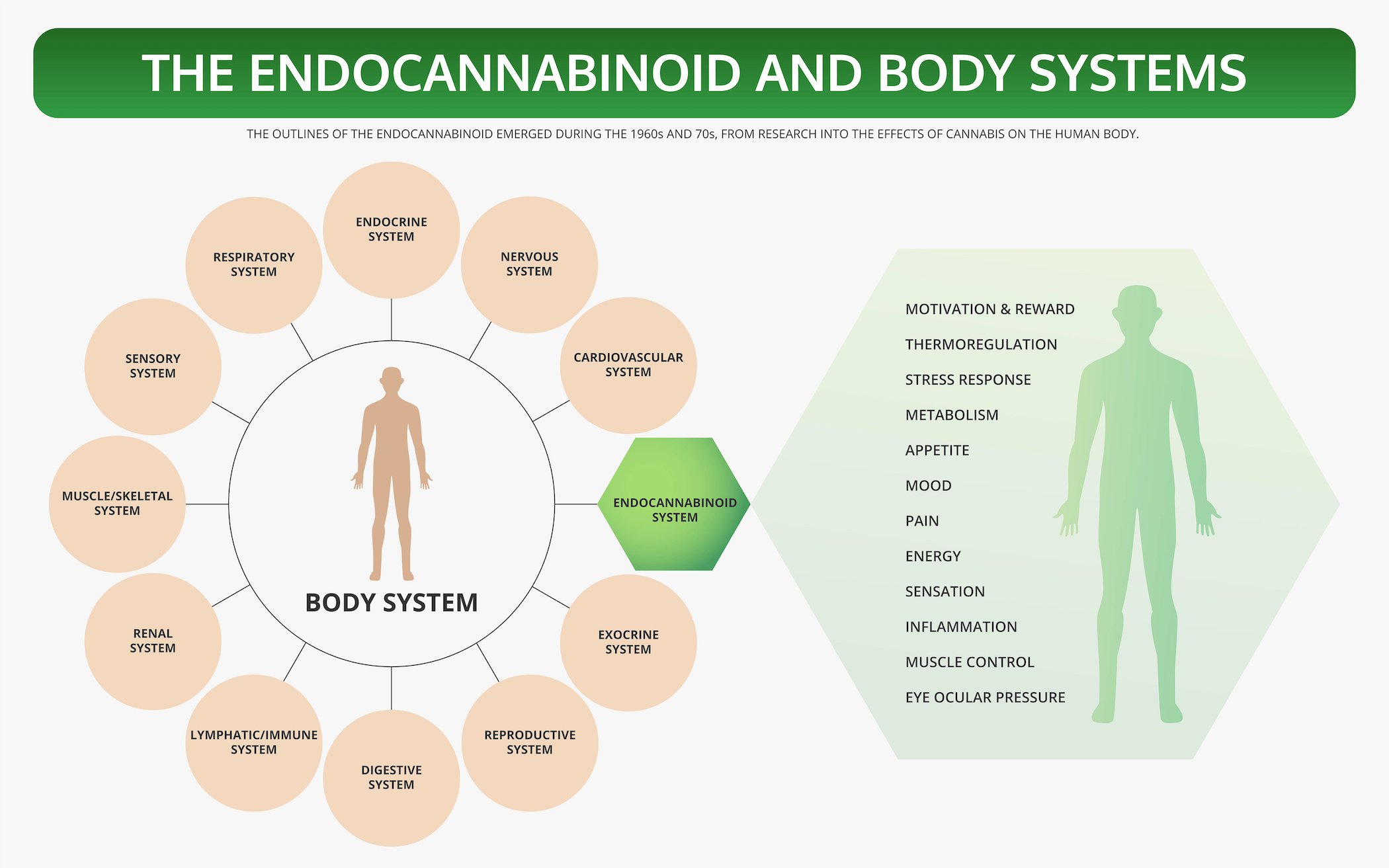The Endocannabinoid System in Simple and Understandable Terms
Many sources miss a very important human body system when they are listed and explained. The endocannabinoid system is too often overlooked and yet so impactful to our daily lives.
And when you google “endocannabinoid system” it does yield a plethora of information. Most of the information is presented in complex medical terminology. A simple description is also warranted. So let’s dig into it.
The endocannabinoid system (ECS) is a biological system that helps regulate and balance key bodily functions. Before we drill into ECS, let’s understand some scientific/medical terminology. The following is provided by Healthline:
Endocannabinoids
Endocannabinoids, also called endogenous cannabinoids, are molecules made by your body. They are similar to cannabinoids, but are produced by your body.
Endocannabinoid receptors
These receptors are found throughout your body. Endocannabinoids bind to them in order to signal that the ECS needs to take action.
There are two main endocannabinoid receptors:
CB1 receptors, which are mostly found in the central nervous system
CB2 receptors, which are mostly found in your peripheral nervous system, especially immune cells
Endocannabinoids can bind to either receptor. The effects that result depend on where the receptor is located and which endocannabinoid it binds to.
Enzymes
Enzymes are responsible for breaking down endocannabinoids once they’ve carried out their function.
The ECS is complicated, and experts haven’t yet determined exactly how it works or all of its potential functions.
THC interacts with your ECS by binding to receptors, just like endocannabinoids. It’s powerful partly because it can bind to both CB1 and CB2 receptors.
Experts aren’t completely sure how CBD interacts with the ECS. But they do know that it doesn’t bind to CB1 or CB2 receptors the way THC does.
Instead, many believe it works by preventing endocannabinoids from being broken down. This allows them to have more of an effect on your body. Others believe that CBD binds to a receptor that hasn’t been discovered yet.
While the details of how it works are still under debate, research suggests that CBD can help with pain, nausea, and other symptoms associated with multiple conditions.
Now that we understand a bit about our ECS and various elements of the ECS, let’s attempt to demystify the endocannabinoid system. One good source that we found was a Ted Talk from Dr. Ruth Ross appropriately titled “Demystifying the Endocannabinoid System | TEDxMississauga.”
Dr. Ross presented the following slide which summarizes when our bodies produce endocannabinoids. They get produced as the result of environmental experiences such as exercise, stress, and even singing. The responses they yield can be an increase in appetite, internal ability to deal with stress and anxiety, and pain relief.
Dr. Ross explains that the ECS acts on CB1 and CB2 receptors found in the brain and different tissues in the body. They unlock downstream responses when our bodies make endocannabinoids. These endocannabinoids are what help us deal with stress, pain, and other unpleasant scenarios. They help us with the formation of helpful memories like dates, names, and lists. But they also help with preventing the formation of emotionally aversive memories such as trauma. There has been more study on THC and less on CBD as it relates to the ECS. THC binds to receptors and either mimics the ECS or disrupts the ECS. There is something in the cannabis plant that is actually an alternative key for a receptor in our brain. Dr. Ross emphasizes that we still need more data. (Source)
Dr. Rachel Knox, in 2019 Ted Talk titled “The endocannabinoid system and the revolution of one” summed it up well:
Now comes the interesting part. The following are excerpts from an article in The Cannigma, “Other plants and the endocannabinoid system: exploring beyond cannabis”:
But perhaps the most miraculous thing that cannabis has done for humanity is help us realize the critical importance of the endocannabinoid system (ECS).
Tetrahydrocannabinol (THC) the high-inducing molecule in cannabis, has opened our eyes to the complex and intricate endocannabinoid system that is shared by nearly all animals of planet earth …
Cannabimimetics, a term which translates to “cannabinoid mimicking,” are molecules from non-cannabis sources that produce their effects via the ECS …
Saying that these plant molecules work by interacting with the ECS is a simplification. Here’s how it really works:
Cannabimimetics work by engaging directly with ECS receptors or indirectly by interacting with important enzymes within the ECS.
These molecules may come in a variety of shapes and sizes, with some looking (chemically) similar to endocannabinoids, while others share their chemical structure with THC and CBD.
Although it’s commonly said that only cannabis makes cannabinoids, there are numerous plant molecules that are similar in shape to the well known cannabinoids found in cannabis. These molecules can technically also be characterized as phytocannabinoids. The prefix phyto- simply means plant and isn’t specific to cannabis. Some of these non-cannabis phytocannabinoids likely have activity in the body similar to those found in cannabis, with one molecule from liverwort even mimicking the effects of THC and causing a “high.”
The enzymes of the ECS are critically important to a healthy endocannabinoid system as they are responsible for the production, destruction, or movement of endocannabinoids. The net function of endocannabinoids, cannabinoid receptors, and ECS enzymes in the body culminates to describe how well the ECS is functioning, or rather the endocannabinoid tone. Consuming a drug or herb that interacts with the degradative enzymes in the ECS can result in a change in the endocannabinoid tone.
Because our knowledge of how the endocannabinoid system works is still relatively new (only first discovered in the early 1990’s), our understanding continues to evolve as we unravel the mysteries of how plants have therapeutic effects in the body. There is, however, an increasingly common suspicion shared by researchers that the effects from consuming specific plants, herbs, and fungi may hold the key to explaining certain fluctuations in endocannabinoid tone. There is also good reason to believe that our diet, in particular the fats we eat, also has a major influence on endocannabinoid tone.
As Lucid Green’s mission is to drive trust and transparency in cannabis, we often promote stronger and deeper education of cannabis. We believe that this emcompasses the endocannabinoid system as well as other aspects of cannabis including the sharing of information on cannabinoids, terpenes, and other topics.
If you would like to learn how Lucid Green delivers the intelligent UPC of cannabis, the LucidID, and/or provides one platform to reduce costs, increase transparency, and drive revenue for cannabis brands, distributors, and retailers, please schedule a demo at https://www.lucidgreen.io/schedule-demo. We would love to help you drive greater success!



